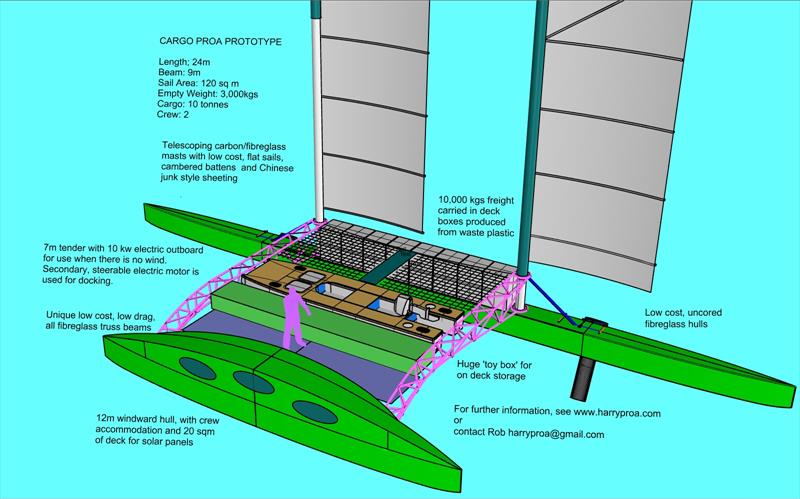
Zero emissions shipping project launched - a 24m cargo proa prototype
by Rob Denney 28 Jul 2022 07:03 PDT

Cargo proa sketch © Harry Proa
Shipping to remote (and not so remote) Pacific villages is expensive, polluting and sporadic.
Either diesel burning ships which need big payloads to justify a visit, cost a fortune to run, spend a lot of time out of commission and are too deep to enter lagoons. Or 6-9m fibreglass skiffs which are unsafe out of sight of land and are powered by 40+ hp outboards burning petrol which no one can afford. Both soak up a huge amount of foreign exchange to buy and run and are big emitters of CO2 in countries desperate to show the world reductions are necessary to slow rising sea levels.
The 24m cargo proa prototype is an alternative to the ships. Wing sail powered, ~1/20th the cost of a diesel burning ship, it can access most villages, loads and unloads on the beach without machinery and is intended to be built locally, creating jobs and saving foreign exchange.
Designed by Harryproa and built by Rob Denney in a shed provided by the University of Queensland, Australia, the prototype was shipped to Fiji for assembly and testing. In a world where everybody talks about green shipping, but very little is being done, a prototype that was low tech and island suitable had an immediate effect. The project was formally launched last week by the Prime Ministers of Fiji and Tonga, along with dignitaries from around the globe.
The requirements for the boat are unique, as are some of the solutions:
It is a proa, with the cargo carried on the 'always to leeward' long hull. This means the beams, masts and rudders can be sized for the empty condition, saving significant weight and cost. The boat shunts, rather than tacking and gybing, which are difficult operations in heavily loaded multihulls, simple in proas. The two crew accommodation is in the smaller windward hull. All sailing is done from the cockpit adjacent to this hull.
The rigs are telescoping wing sections. Unusually, these were chosen for longevity, low operating loads and simplicity of build and operation rather than any performance benefit over conventional sails. The masts also telescope, to reduce windage and build space.
The steering and leeway resistance are combined in rudders at 25% and 75% of the hull length. These are externally mounted to reduce weight, and avoid holes in the hull. The rudders kick up in a collision and are liftable for steering balance and shallow water use.
The cargo is carried in deck boxes, made from recycled plastic trash. They are in different sizes, each carried by up to 8 people. They facilitate rapid turnaround, easy invoicing and cargo tracking.
The hulls are solid fibreglass for toughness and low cost; the masts, beams and rudder blades are carbon fibre. The cost of the composite materials was $US30,000, the boat ready to sail weighs about 3 tons/tonnes and took 18 months of 40 hour weeks for 2 people, with occasional UQ student help. Six months of this was spent experimenting, testing and breaking things. Everything except the rudders was vacuum infused as a flat panel with different edge treatments, variations of laminate, local reinforcing and joint structures all included in the panels which are glued together. No frames or alignment were required.
Cargo capacity in sheltered waters is 10 tonnes, half this for offshore work.
The prototype is a work in progress. The design has evolved a lot since conception. The biggest changes occurred after Denney spent time in the Marshall Islands teaching the locals to build a 7.2m/24' version for near shore transport and fishing. Listening to their requirements resulted in some significant changes. More are expected once the boat goes into service.
The Marshall Islands boat was built from ply and timber in five weeks. It must be carefully maintained and stored out of the weather. A course is being set up at the Centre of Appropriate Technology and Development, Nadave to teach Fijians how to build them using foam produced from ground up soda bottles instead of ply. These boats will last indefinitely, with only a coat of house paint every five years or so to keep the sun off.
Visit here for more information on the Cargo Proa, build blog, including the project launch and the boat in the water, as well as the Marshalls project including video of the boat sailing.